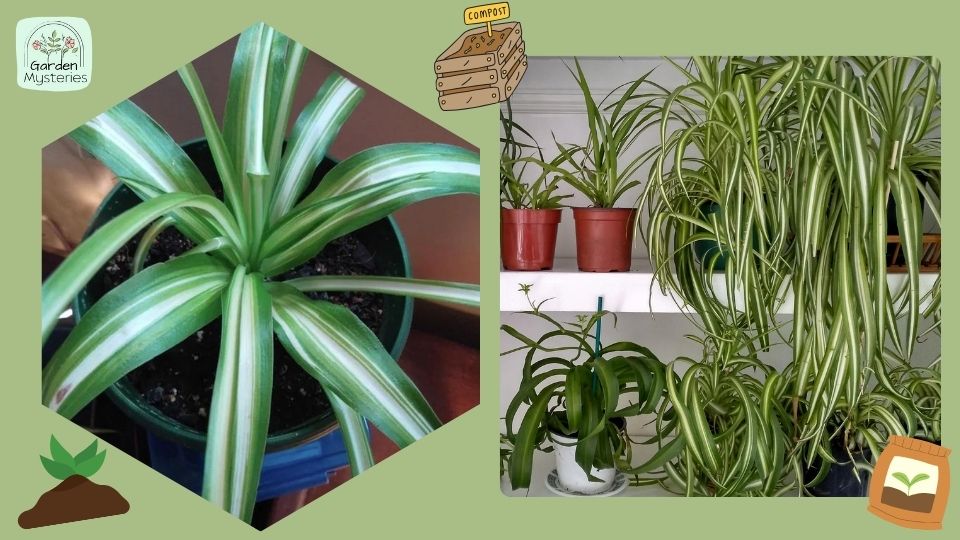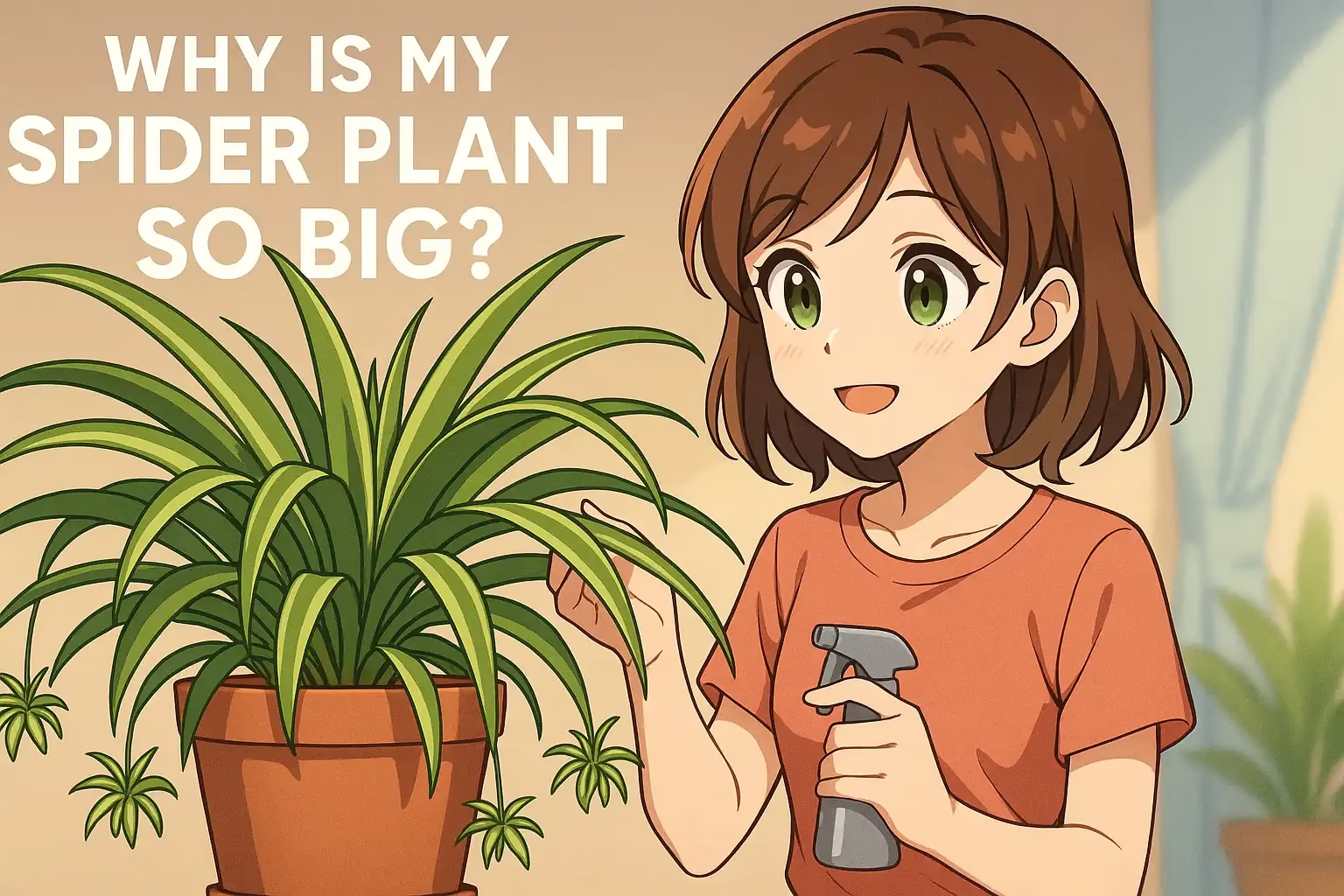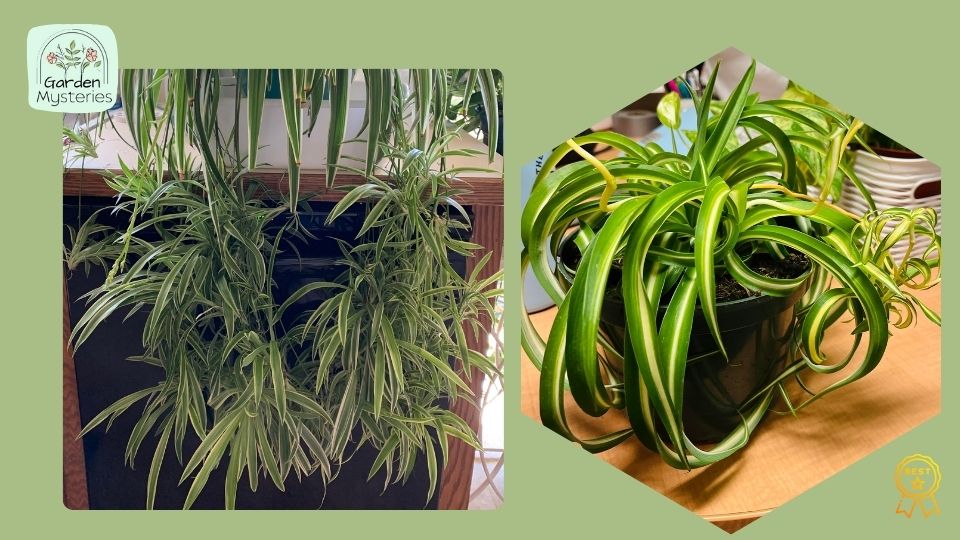Why do My Spider Plants have Wide Leaves? Cause & Facts
Spider Plant (Chlorophytum comosum) has different variations. Each variation has different leaf sizes, colors, and patterns. When I got my first-ever spider plant wide leaves, I talked to a passionate gardener in my neighborhood. He shared a bunch of tips with me about spider plants.
I’m excited to share those secrets of nurturing spider plants wide leaves. It will help you experience the same delight in your home. So, kindly read the blog till the end.
Why Is My Spider Plant So Big?
A large spider plant can be a testament to your green thumb and the favorable conditions you’ve provided for your plant. Several factors can contribute to the size of your spider plant:
- It’s getting older: Your plant is growing up. Just like kids, plants get bigger as they age. So, don’t worry about that.
- Happy plant, big plant: If your plant likes where it’s living, it’ll grow more. Good job giving it a nice home.
- Lots of light: Spider plants love bright spots, but not too sunny. If it’s getting good light, it’ll grow big leaves and lots of babies.
- Just right water: You’re probably watering it well. Not too much, not too little. That’s the trick and you should follow that.
- Plant food: Have you been giving it fertilizer? That’s like vitamins for plants. It helps them grow big and strong.
- Plenty of space: Maybe you gave it a bigger pot? So, more room for roots means more room to grow.
- Comfy room: If you feel comfy in your home, your plant probably does too. Spider plants like normal room temps and humidity.
- Haircut time: Cutting off dead leaves is like a haircut for your plant. It helps new growth come in.
- Baby plants: See those little plants hanging off? Those are babies. So, keeping them on makes the whole plant look bigger.
- Lots of love: Your care makes a big difference. Checking on it and fixing problems helps it grow strong.
How big are the leaves on a spider plant in general?
The leaves of a spider plant (Chlorophytum comosum) are relatively narrow and elongated. Let’s talk about spider plant wide leaves for a sec. You know how they look, right? Long and skinny, kinda like grass on steroids.
So here’s the deal, most of the time, these leaves grow pretty long. We’re talking about 8 to 16 inches. They could be like a small ruler or maybe a big sandwich. That’s how long they usually get. But they’re not wide at all. Usually, it’s just about as wide as your thumb. Skinny little things.
Now, here’s the fun part – not all spider plants follow these rules. Some might have bigger leaves, some smaller. It’s like how some people are tall and some are short. So, plants are kinda the same way.
Why the difference? Well, it could be:
- The plant’s “family” (we call it variety)
- Where do you put it in your house
- How old it is
So if your spider plant doesn’t match these sizes exactly, no worries! It’s just doing its own thing. Also, keep in mind that the dimensions mentioned above represent a general range for the species.
When a Spider Plant Wide Leaves Gets too Big?
When a spider plant becomes too big for its current container or space, it may exhibit several signs. How big are the leaves on a spider plant? Sometimes, these plants can get a bit too big for their own good. Here’s how you can tell if your spider plant needs some attention:
1. The pot is too small
Your plant might be outgrowing its home if you see:
- Roots peeking out of the drainage holes
- The plant is growing slower than usual
- Your plant keeps tipping over
What to do: It’s time for a new home. Get a pot that’s 1-2 inches wider than the old one. Make sure it has good drainage.
2. Too many baby plants
Your spider plant might look messy if:
- There are lots of little plants (we call them “pups”) growing off the main plant
- The main plant looks scraggly
- It’s growing slower than before
What to do: Try to give those baby plants a new home. Then gently separate them from the main plant. Also, you can plant them in new pots or share them with friends.
3. Not enough space
If your plant is in a hanging basket or on a shelf, it might:
- Have tangled or damaged leaves
- Not look as pretty as it used to
What to do: You can give your spider plant a haircut! Trim some of the older leaves and long stems to make it look nice again.
4. The plant looks unhealthy
Watch out for these signs:
- Leaves turning yellow or brown
- The plant isn’t growing much
What to do: You must check if your plant needs more light, water, or plant food. Moreover, you might need to repot it or trim it.
5. Roots are packed tight
If the roots have filled up the whole pot, you might notice:
- Water runs straight through when you water it
- The spider plant grows slowly
- Leaves turn yellow
What to do: Take the spider plant out of its pot. Gently loosen the roots and put them in a bigger pot with fresh soil.
Remember, a happy spider plant is a healthy spider plant. If you take care of these issues, your plant will thank you. Also, it will grow and become even more beautiful.
If you need more tips and tricks articles, don’t forget to explore my website. Recently, I have covered the tips to make a soil mix for your Pothos Cuttings.

Spider Plant Wide Leaves Variation
Spider plants (Chlorophytum comosum) are known for their distinctive arching leaves. Yet, there is a wide variation in leaf characteristics among different spider plant rhizomes varieties.
Also, some spider plants are particularly noted for their wide leaves, which can add unique beauty to your indoor garden. Here are some varieties of spider plant with wide leaves:
Chlorophytum comosum Variegatum
Variegated Spider Plant is one of the most common spider plant wide leaves. The leaves are green with broad, creamy-white stripes running lengthwise along the edges. Moreover, these wide leaves make ‘Variegatum’ a popular choice for its striking appearance.
Chlorophytum comosum Bonnie
The ‘Bonnie’ curling spider plant is known for its distinctive, twisted, and curly wide leaves. The leaves are typically green with white stripes. Also, the unique leaf shape adds an interesting twist to the traditional spider plant appearance.
Chlorophytum comosum Hawaiian
Hawaiian Spider Plant variety features green leaves with white stripes. But what sets it apart is the subtle hint of pink that often appears on the leaves, especially in favorable light conditions. So, these wide leaves with a touch of pink give the ‘Hawaiian’ curling spider plant a tropical and vibrant look.
Chlorophytum comosum Zebra
Although not as wide as some other varieties, the ‘Zebra’ spider plant has unique, bold stripes that resemble zebra stripes. The wide leaves feature a central green band with white stripes on each side, creating a striking pattern.
Chlorophytum comosum Milky Way
The ‘Milky Way’ variety is characterized by its wide leaves with irregular creamy-white streaks. These streaks give the leaves a marbled or speckled appearance. Also, it adds an element of unpredictability to the wide leaf spider plant’s overall look.
Chlorophytum comosum Bonnie Curly
Similar to the ‘Bonnie’ spider plant, the ‘Bonnie Curly’ variety features wide leaves. Those leaves are twisted and curly, creating a captivating and whimsical effect. The leaves are typically green with white stripes.
Growing Spider Plants With Wide Leaves
Spider plants (Chlorophytum comosum) are popular plants for their ease of care. Here are some essential spider plant care tips to help you keep your spider plant healthy:
Light
- Spider plants prosper in bright, indirect sunlight. So, you should place them near a window with filtered light or in a spot where they receive indirect sunlight for a few hours a day.
- They can tolerate lower light conditions but may grow more slowly and produce fewer offshoots.
Watering spider plants wide leaves
- Try to keep the soil evenly moist but not waterlogged. You should water when the top inch (2.5 cm) of the soil feels dry to the touch.
- Be cautious not to let the spider plant sit in standing water, as this can lead to spider plant roots rot.
Humidity
- Spider plants wide leaves prefer moderate humidity levels. If your indoor air is dry, consider using a humidity tray or a room humidifier to maintain adequate moisture.
Temperature
- You should maintain room temperatures between 60°F to 75°F (15°C to 24°C). Also, they can tolerate slightly cooler conditions but are sensitive to frost.
Soil
- Always try to use a well-draining potting mix that contains peat moss and perlite or vermiculite. Additionally, a mix designed for indoor plants or tropicals is suitable.
Potting and Repotting
- You should start with a small pot and repot your limp spider plant as it grows. Also, a slightly larger pot is usually sufficient.
- Repotting every 1-2 years is often recommended to refresh the soil and provide room for growth.
Fertilization
- You can feed your leggy spider plant with a balanced, water-soluble fertilizer diluted to half strength every 2-4 weeks. It should be during the growing season (spring and summer).
- Reduce or eliminate fertilizer during the fall and winter when the plant’s growth slows down.
Pruning and Maintenance
- You should remove brown or yellowing leaves as they appear to maintain the overgrown spider plant’s appearance. Also, It encourages new growth.
- You can trim long, leggy stems to promote a more compact and bushy shape.
Pest Control
- Keep an eye out for common houseplant pests like spider mites and mealybugs. If you notice any infestations, treat them promptly. Also, you can apply appropriate measures like insecticidal soap.
Propagation
- Spider plants produce “pups” or offshoots that can be separated and replanted as new plants. This is an excellent way to expand your spider plant collection or share with others.
Pot Selection
- You should choose a pot with drainage holes to let the excess water escape. So, proper drainage is essential to prevent overwatering.
Toxicity
- Spider plants are non-toxic to humans and most pets. So, it makes them a safe choice for homes with children or animals.
Spider Plant Care Tips
Spider plants (Chlorophytum comosum) are very popular houseplants. They are known for their air-purifying qualities and ease of care. Here’s how to keep your spider plant happy:
- Light: You must put your plant in a bright spot, but not in direct sunlight. Also, it likes to be in the light, but not sunbathing.
- Water: Feel the soil with your finger. So, if the top inch feels dry, it’s time to water. Easy peasy.
- Soil: You must use potting soil that drains well. Your plant doesn’t like wet feet.
- Pot: Make sure your pot has holes in the bottom. Also, this lets extra water escape with ease.
- Temperature: Keep your plant in a room that feels comfortable to you. So, if you’re comfy, your plant probably is too.
- Food: During spring and summer, give your plant some fertilizer every few weeks. So, it’s like vitamins for your plant.
- Haircut: You can cut off any yellow or brown leaves. Also, it keeps your plant looking fresh.
- Bug watch: Keep an eye out for tiny bugs. So, if you see any, ask at a garden store for help.
- New home: If your plant looks squished in its pot, it might need a bigger one.
- Baby plants: See those little plants hanging off? You can plant those to make new spider plants.
FAQs
Why are the leaves on my spider plant with wide leaves turning brown at the tips?
Browning leaf tips on spider plants can result from dry air, excessive fertilizer, or fluoride in tap water. To prevent this, maintain moderate humidity and reduce fertilizer. Also, you should consider using filtered or distilled water.
Are spider plants with wide leaves safe for pets?
Spider plants are considered non-toxic to most pets. While ingestion may lead to mild gastrointestinal upset, they are generally safe for households with cats and dogs.
Can spider plants with wide leaves be grown in hydroponics or water culture?
Yes, spider plants can be grown hydroponically or in water culture. So, ensure that the roots are submerged in the water, and use a hydroponic nutrient solution at half strength for regular feeding.
Do spider plants with wide leaves produce flowers, and how can I encourage flowering?
Spider plants can produce small, white flowers on long stalks. While they don’t typically flower indoors, you can encourage flowering by providing ample indirect light. It will help the plant to mature quickly.
Before saying goodbye, you can go through another article I covered on smaller leaves on Monstera Adansonii. You might find it helpful.







